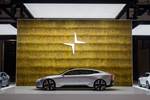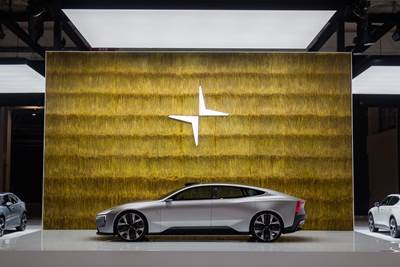Polestar 3 sets World Record for longest electric SUV journey on single charge
Unmodified Polestar 3, which uses natural fiber composites in its interiors, achieves 935.44 kilometers on a single charge on U.K. public roads.
Source (All Images) | Polestar
’s (Gothenburg, Sweden) large electric SUV, the Polestar 3, has broken the Guinness World Record for longest journey traveled by an electric SUV on a single charge. Achieving 935.44 kilometers (581.3 miles), the recently launched long-range single-motor variant was pushed to its limits.
The attempt took 22 hours and 57 minutes to complete in mixed weather conditions including rain. The Polestar 3 achieved an efficiency of 12.1 kilowatt-hours/100 kilometers. Professional efficiency drivers, Sam Clarke, Kevin Booker and Richard Parker, switched every 3 hours to maintain alertness. The Polestar 3 achieved its WLTP figure of 706 kilometers with 20% of its battery capacity still available and delivered an extra 12.8 kilometers after showing 0% battery — but the Polestar 3 reached a charger before ultimately stopping.
“This official Guinness World Record for range is another proof point that Polestar 3 is setting new standards,” says Polestar CEO Michael Lohscheller. “We will continue to push the boundaries of technology and electric performance.”
“While the drivers pushed the Polestar 3 to the boundaries of its range capability, it goes to show how battery range has improved exponentially over the past few years,” says Matt Galvin, Polestar UK managing director. “For a large premium SUV to go way beyond a London-to-Edinburgh distance is truly impressive and with this, the adage that ‘EVs can’t go far’ has been very much consigned to the history books.”
The production-standard SUV was adjudicated by Guinness World Records judge, Paulina Sapinska, with Webfleet providing meticulously documented and independently verified video footage, odometer readings, GPS readings and battery level data. The car received zero modifications for the attempt and was on standard 20-inch wheels fitted with standard Michelin Sport 4 EV tires. The attempt was supported by the AA.
Polestar 3 features natural fiber composites
Polestar and Bcomp worked together to develop the Polestar Signature Weave material used in the seat shells of the Polestar 3. A blend of flax fiber textile, natural fiber composite and Bcomp powerRibs, it reduces plastic usage and weight. See
Polestar 3’s use of natural fiber composites featuring materials from Bcomp (Fribourg, Switzerland) was highlighted on . “We understood the huge potential of this material and, finally, after years of development together with our suppliers — and Bcomp — we’ve found the key to applying it in high-volume production,” says Maximilian Missoni, Polestar head of design. “Our own signature weave brings a luxurious and technical finish to this natural fiber composite, which means it can now be used as a functional and visual material.”
“Taking the step into volume production means we have now unlocked the potential for more natural fiber composites in our cars,” Missoni continues. “It leads to less than half of the fossil-based content compared to traditional premium solutions used in automotive interiors, and it reduces the CO2 emissions of these components by more than 50%.”
Polestar is the Swedish electric performance car brand. It has three models in its line-up: Polestar 2, Polestar 3 and Polestar 4. Planned models include the Polestar 5 four-door GT (to be introduced in 2025), the Polestar 6 roadster and the Polestar 7 compact SUV. With its vehicles currently manufactured on two continents, North America and Asia, Polestar plans to diversify its manufacturing footprint further, with production of Polestar 7 planned in Europe.
Related Content
SMC composites progress BinC solar electric vehicles
In an interview with one of Aptera’s co-founders, CW sheds light on the inspiration behind the crowd-funded solar electric vehicle, its body in carbon (BinC) and how composite materials are playing a role in its design.
Read MoreCarbon fiber, bionic design achieve peak performance in race-ready production vehicle
Porsche worked with Action Composites to design and manufacture an innovative carbon fiber safety cage option to lightweight one of its series race vehicles, built in a one-shot compression molding process.
Read MoreHonda begins production of 2025 CR-V e:FCEV with Type 4 hydrogen tanks in U.S.
Model includes new technologies produced at Performance Manufacturing Center (PMC) in Marysville, Ohio, which is part of Honda hydrogen business strategy that includes Class 8 trucks.
Read MoreInfinite Composites: Type V tanks for space, hydrogen, automotive and more
After a decade of proving its linerless, weight-saving composite tanks with NASA and more than 30 aerospace companies, this CryoSphere pioneer is scaling for growth in commercial space and sustainable transportation on Earth.
Read MoreRead Next
Polestar announces production plans for natural composites-intensive BEV
The Precept battery electric vehicle, developed by Volvo’s Polestar brand, is said to feature Bcomp interior and exterior flax fiber composite panels.
Read MoreScaling up, optimizing the flax fiber composite camper
Greenlander’s Sherpa RV cab, which is largely constructed from flax fiber/bio-epoxy sandwich panels, nears commercial production readiness and next-generation scale-up.
Read MoreNext-gen fan blades: Hybrid twin RTM, printed sensors, laser shock disassembly
MORPHO project demonstrates blade with 20% faster RTM cure cycle, uses AI-based monitoring for improved maintenance/life cycle management and proves laser shock disassembly for recycling.
Read More












